Please Take Note: This is a review of the game’s final prototype. The art, game bits, and the rules discussed are all subject to change. The game is being reviewed on the components and the rules provided with the understanding that “what you see is not what you might get” when the game is published. If you like what you read and want to learn more, we encourage you to visit the game’s web page or visit the Kickstarter campaign. Now that we have all that disclaimer junk out of the way, on with the review!
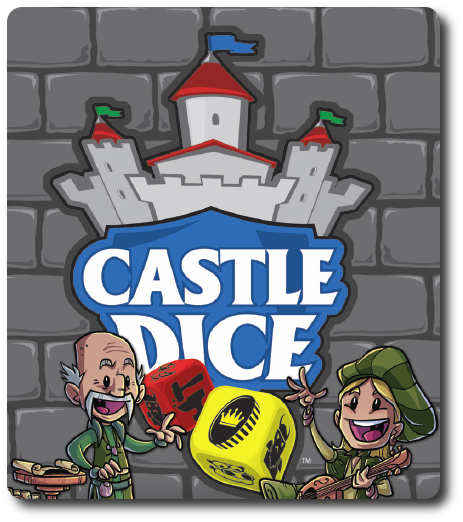
The Basics:
- For ages 8 and up
- For 2 to 4 players
- Approximately 30 minutes to complete
Geek Skills:
- Active Listening & Communication
- Counting & Math
- Logical & Critical Decision Making
- Reading
- Pattern/Color Matching
- Strategy & Tactics
- Risk vs. Reward
- Hand/Resource Management
- Worker Placement
Learning Curve:
- Child – Easy
- Adult – Easy
Theme & Narrative:
- Prove your ability to rule the kingdom by organizing, directing, and protecting the people of the realm!
Endorsements:
- Gamer Geek approved!
- Parent Geek approved!
- Child Geek approved!
Overview
The old king summoned his children before him and looked them over, one by one. They were all strong, noble, and carried themselves as true Princes and Princesses of the Realm. But which among them would be the best to lead the people, manage the kingdom’s precious resources, and protect the population from the barbarian savages? The old king thought and thought and then smiled. He would send his children to different corners of the kingdom, and there, be tasked to raise a castle of their own. Whomever did so to the standards of the king after 7 years would be given the throne.
Castle Dice, by Fun to 11, is comprised of 65 Castle dice (representing the resources of Wood, Stone, Gold, Land, and Iron), 60 Animal tokens (representing Pigs Chickens, Cows, and Horses), 50 Worker tokens (representing Farmers, Merchants, Miners, and Guards), 47 Villager cards, 47 Castle cards, 21 tracking beads, 18 Feast cards, 4 Player mats, and 1 Turn Tracker mat. As this is a review of a prepublished version of the game, we will not comment on the component quality. We will state, however, that the proposed and provided illustrations are exceedingly well done and compliment the game’s narrative brilliantly.
Game Set Up
To set up the game, first give each player a Player mat and 5 tracker beads. The mats are placed in front of the players and the beads are placed on icons for Wood, Stone, Gold, Land, and Iron located on the Player mat. Leave enough room between all the players in the playing area. This open area is referred to as the “World Pool”.
Second, place the Turn Tracker mat to one side of the playing area where at least one player can easily reach it, but visible to all the other players. Place a tracker bead on the “Turn 1” space.
Third, separate the cards into 3 decks. These are the Villager deck, the Castle deck, and the Feast deck. Shuffle each deck thoroughly and place each deck, face-down, where all the players can reach them.
Fourth, place all the dice to one side of the playing area or keep them in a tray for easy storage. Create a pile for the Worker tokens and the Animal tokens, as well. These areas are referred to as the “Banks”. It is suggested that each bank be assigned to a player for easy management. For example, one player would manage the dice Bank, another player the Worker Bank, and another player the Animal Bank. The bankers for these game bits and resources are responsible for keeping the piles organized and assisting players in getting the right bits as requested. This is a great “job” to give to a little geek!
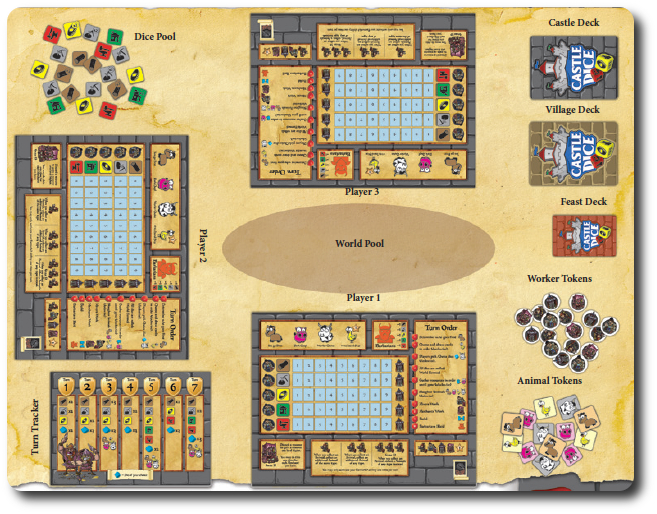
Example of game setup
That’s it! Time to play!
Castles and Kingdoms
It is rare to teach a game, or even summarize the game play, by simply playing it. Castle Dice is one of those games where it is actually beneficial to briefly explain the game by summarizing the 10 phases of a single round and then having all the players participate in the first turn of the game. The “learn as you go” model has a number of cons, but for Castle Dice it is a very effective method of teaching the game to new players. For full details and additional examples of each phase, refer to the game rules available from the Kickstarter page.
The game is played in 7 turns with each turn being broken down into 10 phases. On each phase, all the players will complete the required action. Only after all the players have had a turn will the next phase begin. Each of the 10 phases are summarized here.
Phase 1: Turn Order
When the game first beings, all the players will take 2 Wood dice (the dice with the log image on it) and roll them. The player who rolls the highest amount of Wood goes first for the first turn with player turn order going clockwise. During the next six rounds, the player with the most Horses (an Animal resource a player can collect) goes first. If there is ever a tie (meaning there is no single player who has the most Horses), the first player for the turn is the next player going clockwise from the player who started the last turn.
Phase 2: Draw Cards
On the first turn, none of the player will have any cards. A player can hold a maximum of 5 cards with any combination of Castle and Village cards. Feast cards never count towards a player’s hand size limit. During the next six turns, players could have cards in their hand they did not play or simply do not want. These can be discarded to allow a player to draw more Castle and Village cards. Starting with the first player of the turn and going clockwise, all the players will complete the following:
- Discard any cards in hand to a discard pile, face-up, next to the deck from which the card came from
- Draw any number of Castle or Village cards without going over the hand size limit of 5 cards
The player with the most Chickens this turn has a hand size limit of 6 cards.
If a deck is ever exhausted, simply reshuffle the discard pile to make a new deck.
Phase 3: Collect Dice
Each turn assigns what dice, at minimum, all the players will roll. This, thematically speaking, sets what resources available to collect in the world where the game is taking place. For the first turn, for example, all the players will roll 2 Wood dice, 2 Stone dice, and 1 Gold die. Additionally, every turn allows the players to select a preset number of extra dice of the player’s choice. These extra dice can be of any type, but they must be available from the dice Bank. Starting with the first player for the turn and going clockwise, each player will select the extra dice of their choice from what is available.
Before this phase is over, the player who has the most Cows can change one of their Workers (Farmers, Merchants, Miners, and Guards) to any other type of Worker. For example, a player could change their Miner to a Guard.
Phase 4: Roll Those Dice!
Now all the players take the dice they selected and roll them at the same time in the middle of the playing area, referred to earlier as the “World Pool”. Be careful to keep all the dice rolls separated. All Barbarians that are rolled on the dice are collected by the player who rolled them. The Barbarians are placed on the Player mat in the Barbarian Camp area and all the other dice are left in the World Pool area.
Phase 5: Gathering Resources
Starting with the first player for the turn and going clockwise, players will pick one die from the World Pool. If the die collected by a player shows a resource, the tracker bead for that resource is shifted accordingly and the die is placed back in the dice Bank. If the die collected by a player shows an animal, the player immediately takes a matching Animal token from the Animal Bank and adds it to their Player mat. Players continue to gather one die each going in a circle until all the dice are gathered. It is possible that one or more players will collect more dice than the other players.
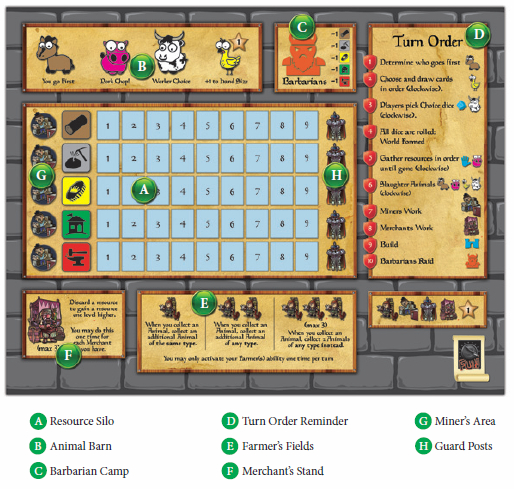
The Player mat – an incredibly useful tool for running a kingdom
At this time, some cards can be played. The icon representing an open hand indicates that the card can be played during this turn’s phase. The card will define when it can be played and its effect.
Any player who has the most Pigs during this phase can perform the special action called “Pork Chop”. This allows the player to change the rolled result of one die in the World Pool before they gather it. This special action can only happen once per turn, meaning a player who gathers enough Pigs to become the dominant Pig collector cannot use the “Pork Chop” action if another player has already done so. While powerful, this action is also limiting. Once a player performs the “Pork Chop” action, they can no longer gather any resources for the duration of this phase. Note that there is a card that can be used during this phase that allows the player who plays it to perform the “Pork Chop” action regardless of their Pig count or if another player has already used the action.
Phase 6: Slaughter Animals
A bit of a shame, really, as the illustrations on the animals are actually pretty cute. Oh, well. No matter. The cute cow will make for an adorable burger, I’m sure.
After the last die has been taken from the World Pool, starting with the first player for the turn, collected sets of Animal tokens can be traded in for Feast cards. If the player does want to trade in their Animal tokens, they return to the Animal bank 1 Horse, 1 Chicken, 1 Pig, and 1 Cow for every 1 Feast card drawn. Again, Feast cards do not count towards a player’s hand size limit.
Slaughtering animals is optional. A player can simply skip this phase if they choose. Turns 3, 5, and 7, are considered “holidays’ and player must turn in sets of Animal tokens if they have them. These are the only turns that force a player to trade in their animals.
Phase 7: Miners Go To Work
Each player now reviews their Player mat and for each Miner Worker they have on one of their resources, the tracker bead is increased by one.
Phase 8: Merchants Open Shops
Each player now reviews their Player mat and for each Merchant they have, they can then discard 1 resource (reduce the tracker bead value) to gain 1 resource (increase the tracker bead value) that is slightly rarer.
- Discard 1 Wood to gain 1 Stone
- Discard 1 Stone to gain 1 Gold
- Discard 1 Gold to gain 1 Land
- Discard 1 Land to gain 1 Iron
Note that a player can never have any more than 9 of any resource.
Phase 9: Build
Starting with the first player for the turn, players now play cards from their hand that allow them to hire Workers and build castle parts. The noted number of resources the Worker or castle parts will cost is on the card. This is paid immediately when the card comes into play. There is no limit to the number of cards a player can build and are only limited by their available animals and resources for that turn. All cards that can be built have a castle icon on them indicating the phase they can be played.
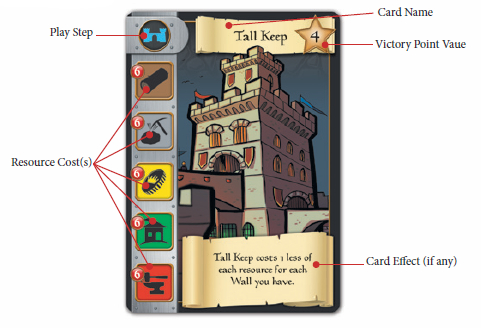
Example of a build card and the information it contains
Cards that represent portions of a player’s castle are played to one side of the Player mat. Cards the represent Workers are paid for and then discarded. A matching Worker token is taken from the Worker Bank and then placed on the Player mat. Miners automatically get sent to the most common resource not currently occupied by another Miner, Guards are dispatched to any resource that doesn’t have a Guard already watching it, and Farmers and Merchants are sent to their spots on the Player mat.
Phase 10: Barbarian Raids!
After a successful year of farming and selling, raising livestock, collecting precious resources, and building your castle, it should come as no surprise that the Barbarians come down from their homes in the mountains to take that which you have worked so hard to obtain. For each Barbarian on the Player’s mat, all the resources that do not have a Guard on it are reduced by one. This is done until all the Barbarians have been accounted for and discarded back to the dice Bank.
For example, if a player has collected 3 Barbarians during phase 4, all the resources that are not protected by a Guard are reduced by 3.
The turn marker is now adjusted on the Turn Marker mat with the next turn starting with phase 1.
Continuing the Game and Ending It
After the turn ends, a new one begins with the first phase. This continues until the 7th and final turn is completed with the Barbarians rushing down and taking whatever is not guarded. After that, it is time to determine who the winner of the game is.
- Any players with a “Bard” Feast card now reveals them (1 victory point each)
- The player with the most Animals gets 1 victory point
- The player with the most Workers gets 1 victory point
- Any castle parts built are reviewed for possible victory points
The player with the most victory points wins the game!
To learn more about Castle Dice and read the full rules, visit the game’s web page or visit the Kickstarter campaign. If you are feeling particularly creative and have a lot of time on your hands, the game can be printed and played for free.
Prediction
This game, despite having a lot phases, is actually very easy. Each phase has the players take a very specific action. This makes teaching the game and guiding new players through a game as easy as telling a person how to comb their hair. Admittedly, the end result might be a big mess, but the steps they take are easy to describe and to follow. Additionally, the endgame scoring is exceedingly simple and most of the points to be won and who is currently in the lead can be seen by just scanning the table. What is not known are any points given by Feast cards.
From a Child Geek perspective, this game is intimidating, with the cartoonish characters and their happy faces doing little in the way of calming an individual who feels overwhelmed by the game’s weight. To put it another way, this game is an elephant, but even an elephant can be eaten if one takes enough small bites. The game designer has done a masterful job of breaking down the game into 10 distinct phases with the goal of each phase very clear. This breaks down the elephant into very small and manageable parts. Lacking any type of timer, a person who is teaching the game can linger as long as necessary on any phase until the other players all feel comfortable.
And yet, despite the simplicity of each phase, this is no easy game. Each phase contributes to the outcome and impact of the phases to follow, both in the current and future turns. This makes the easy choices presented in each phase have a long-lasting influence in the game. Luckily, there is nothing in the rules to suggest that a poorly executed phase or phases results in an unrecoverable game. There is more than enough wiggle room for a player to explore many different tactics and strategies without the fear of ever being left far behind. The final game scoring has seen to that.
As I had hoped and predicted, the game was easy to teach but it was surprisingly hard to get the Parent and Child Geeks to sit down for a game. Again, the game feels big and looks big. A player unfamiliar with the game can easily feel lost in the rather broad shadow it casts. This is an optical illusion, however, and once I was able to get a player to sit down and see the game in motion, any traces of doubt left their faces.
The easiest way to teach this game is to walk all the player’s through the first turn and then take a quick look at points collected so far. As each phase is identical to the last, each turn reinforces what the players have learned and they very quickly start to make better and more informed choices. While the math is simple, there is a lot of reading in the game. This made it a difficult one play with my 5-year-old, but my 8-year-old had no issues understanding what he read on the Player mat and the cards. He very quickly grasped the overall concept of the game and how it was played. This had to do partially with how the game is organized to play, but also because my 8-year-old is no stranger to Euro-style games that use resource management and collecting as part of its game mechanisms.
And so, after going through a high-level explanation of all the game components and how the game was played, my little geek and I were ready to play our first turn. Before we began, I asked him this thoughts on the game so far.
“OK, well, the game looks really big, but you said it is played in smaller portions, so I think I can play the game well enough.” ~ Liam (age 8)
I hear a lot of doubt in his voice. Let’s play the game and see if I can turn that worried frown upside down!
Final Word
After one turn, his concerns had all but washed away. He quickly understood what was needed in each phase, how each phase piggy-backed on the previous phases, and how to win the game. He focused on Animals and Guards, collecting Workers when and where he could. His level of resource management wasn’t as strong as I would have liked, but he was able to collect Feast cards like a Boss. At the end of our first game, he lost by 1 Victory point. Just one. Not bad for an 8-year-old little geek! But more important than his final score was how he shifted his focus during the second half the game. I became aware that he was counting points at the table and he was starting to make moves to fill in what he believed were gaps. This, above all else, pleased me the most. He was clearly paying attention to the game, doing the math in his head, and using what he knew about the game to get ahead. All important geek skills to win games and be successful in life.
Parent Geeks had a wonderful time with this game because it can be played exceedingly casual. Since all the actions happen at once or in player order, it is easy to pause the game to fulfill a little geek’s juice request, change a diaper, or to simply pause the game for a moment to see why the children have become so quiet in the next room. Interruptions do little to upset the game’s level of excitement because the game itself is designed to play at a pace that is suitable to the group, not the individual player. This did, however, lead some Parent Geeks to suggest the game took too long during some phases. A statement they made, I feel, without fully understanding why the phase took longer than they thought it should. Since the phase doesn’t end until all the players complete their action, each phase is only as fast as the slowest player. Non-gamers really enjoyed the game once I sat them down to play it. That, in itself, was a major victory. Non-gamers took one look at Castle Dice and immediately started to back-peddle. While I never had to physically force a non-gamer to play the game, I did have to wrestle with them emotionally to take a seat. A bit exhausting, but well worth it.
Gamer Geeks either enjoyed the game or hated it. Their reasons for loving or hating the game were obvious. Based on their predefined notions of what made a “good game”, the Euro-style game play turned them on or turned them off within the first round. For those who stated they hated the game because they hated Euro-games, I did not bother to record it towards the overall endorsement score. If you don’t enjoy Euro-games, you won’t like this game. That’s a pretty easy statement to make. Likewise, I didn’t bother to record the players who said they loved Euro-games for the same reason. Endorsement levels are based on game play experience and not predefined levels of gamer geek elite subjective stances on Euro-games as a whole. For those players who said they didn’t mind Euro-style games or were open to any type of game, Castle Dice was highly approved.
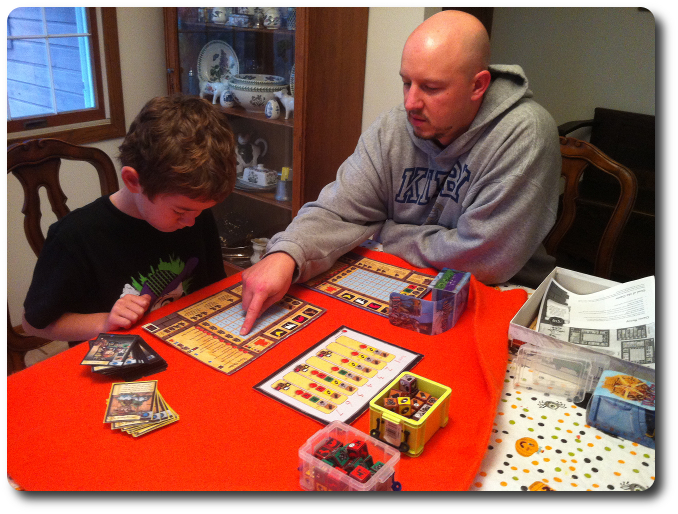
My wife took this picture of what she calls “father and little geek bonding time”
Gamer Geeks, this is a Euro-game through and through. It plays light, fast, and is pretty easy to manage. I wouldn’t go so far as to suggest that this will be a difficult game for you to master, but it does require some careful planning when selecting resources and protecting your hard-earned materials from the Barbarians. The random cards provide for a subtle change of pace from most Euro-style games and this is where some of the purest might get a little ticked off. What you can or cannot build is dependent on the resources you have AND the cards you have in your hand. This means you have to sometimes blindly collect resources because you don’t have much in the way to build, but this is a very rare occurrence. Most of the time, and because players get to discard and draw new cards every round, you’ll have more than enough choices to make. Perhaps the most enjoyable aspect of this game for your peer group was how very streamlined the game felt. For you, the more advanced players, a single phase will only take about a minute or two as all the players can complete their actions at the same time. We were able to play 2 games within 1 hour with time to spare.
Parent Geeks, as far as Euro-style games go, this is a real winner and an excellent one to put on your table to introduce to the family and friends. Players will be able to collect animals and resources, build castles, and defend their kingdom in a single turn of the game. Players will quickly learn the basics and then enjoy the challenge of the more complex advanced aspects of the game play. Players who know nothing of resource management games will be assisted and greatly benefit from the Player mats and the predefined possible actions per phase. Non-gamers enjoyed the game as much as the Parent Geeks and the game was found to be a fun one for the entire family, regardless of skill level.
Child Geeks, this is a great way to learn about resource management and planning. You’ll know what’s coming up and be able to prepare for it. The game does not punish you if you make a mistake and there is more than enough time to correct any faults you feel are in your strategy and tactics. The game plays fast and you’ll be learning how to manage a castle and a kingdom in no time. Reading is necessary and so is math, but neither is heavily used to a point where you’ll be spending a great deal of your time looking through cards or counting on your fingers. Your best friend in this game will be your Player mat as it gives you all the information you’ll need to play the game and help you organize yourself for victory!
Castle Dice was a very pleasant surprise. I am familiar with Euro-style games and I’d say I fall squarely in the “like to love” range for these types of games. I have always enjoyed a game play experience that lets me build something and refine it. I can’t help it, it’s the architect in me. Castle Dice allows me to do just that in a casual and social way with all the other players. Everyone shares the same dice pool, but everyone influenced it with their rolls and the dice they selected. This was a neat twist and I was able to see what my opponents were going for, taking special note to select some of their dice when I thought the time was right.
This game is also very well-balanced, but my highest point of praise goes to the game’s ability to be taught as it is being played without penalizing new players or giving veteran players a big advantage. The first turn is pretty much just a “warmup” and the rest of the game allows the players to set themselves up for a win. The break down of the phases were meaningful and I never felt that my opponents or I were being forced to do anything we didn’t want to. The one exception were the holidays that forced players to give up some of their animals. Even so, this served to keep the game balanced, too, knocking down those who simply had to many, awarding them in the process, but also giving all the other players a chance to make their move.
Simply excellent and I look forward to playing this game again as soon as I can. Sadly, my review copy will be sent off to another game reviewer for others to try. While I am most pleased to see the game get on a new table, I am somewhat disappointed I can’t play the game again with my family and friends.
If you are a fan of Euro-style games or simply want to know what they are all about, do get your hands on Castle Dice. It is family friendly, easy to teach, fast, and engaging. You’ll have fun, trust me.
This game was given to Father Geek as a review copy. Father Geek was not paid, bribed, wined, dined, or threatened in vain hopes of influencing this review. Such is the statuesque and legendary integrity of Father Geek.




Yes, I am aware my children have more hair than me. Stop bringing it up, people.